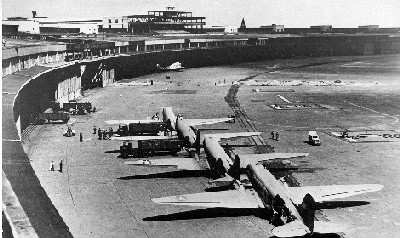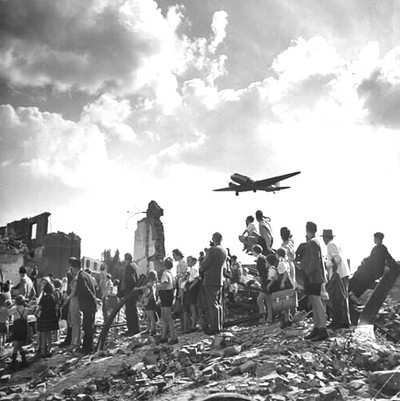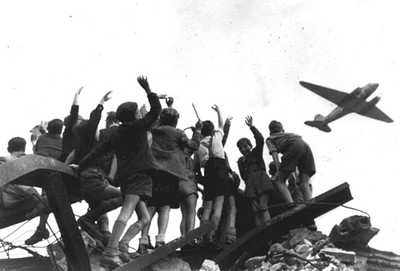Berlin Airlift Dispensed Food, Delivered Blow To Communism
With the 60th anniversary of the Berlin Airlift approaching in
June, the US Air Force is taking steps to recognize the massive
operation that relieved some 2.5 million beleaguered Berlin
residents and stretched the Soviet Union's Iron Curtain at its
seams.

US and German officials will pay tribute to the 60th anniversary
of this effort at the Joint Service Open House this weekend at
Andrews Air Force Base, MD.
In the largest humanitarian mission in Air Force history,
"Operation Vittles" -- better known as the Berlin Airlift --
delivered more than 2.3 million tons of food, fuel and other
supplies to residents of the German capital.
This massive aerial effort, jointly carried out by US and
British air forces from June 1948 through September 1949, was born
of post-World War II tensions between the allied powers and the
Soviet Union.
At the war's conclusion, the victors divided Germany into four
occupation zones: the American, British, and French zones in the
west, and a Soviet zone in the east. Within the Soviet zone lay
Berlin, which also was divided into four sectors, each administered
by one of the wartime allies, according to the Air Force History
Web site.
Displeased with the terms of post-war restructuring, the Soviet
Union, which controlled roads and railways leading into Berlin's
allied sectors, blocked the Western powers' ground access to the
western portion of the German capital on June 24, 1948. Many
historians agree that Joseph Stalin, then the leader of the Soviet
Union, imposed the aggressive restrictions in an attempt to extend
Russia's communist sphere in Europe and exploit the allies'
vulnerabilities.

"Despite its monopoly of atomic weapons, the United States had
few options. Berlin lay deep inside Soviet-controlled Germany, and
the United States maintained approximately two divisions in
Europe," said Air Force historian Maj. Harry R. Borowski in an
essay on the Air and Space Power Journal Web site. "In ground
strength, Joseph Stalin held the trump cards."
Meanwhile, appeals for relief emanated from West Berlin, where
residents, isolated from the outside world, faced starvation and a
dearth of vital materials. In the early stages of the relief
operation, West Berlin's Mayor Ernst Reuter, before a crowd of some
300,000, delivered a now-famous speech that captured the zeitgeist
of desperation.
"People of this world, look upon this city and see that you
should not and cannot abandon this city and its people!" Reuter
implored, the burned-out Reichstag building formerly used by
Germany's Parliament standing as a precarious backdrop. The
audience heard his plea, and so did the allied powers.
With too few ground forces to breach the blockade, and the
survival of the 2.5 million West Berliners in the balance, Western
allies looked to the sky for an answer. Operation Vittles began
June 26, 1948 -- two days after the blockade -- when C-47 Dakota
military transport aircraft took off for the German capital.
On the first day of the operation, C-47s made 32 flights into
West Berlin's allied sectors carrying 80 tons of cargo, mainly
powdered milk, flour and medicine, according to the Air Force
History Office Web site. It became clear to American officials in
the first month of the operation that a massive airlift of
indefinite duration afforded the only alternative to war or
withdrawal, the site noted.
In what is regarded as one of the first maneuvers in the
chess-like Cold War that would define US-Soviet relations for the
next four decades, the humanitarian and ideological mission helped
define the players involved.

"The Berlin Airlift was a watershed event in the Cold War in
that it proved the determination of the United States to do
whatever was necessary to support the freedom of the people of
Berlin, and, by extension, the free people of Europe," said retired
Navy Adm. Charles S. "Steve" Abbot, a former deputy commander of US
European Command. "History has shown that we made good on that
commitment."
During the 10-month mission, more than 500 American and British
airlifters conducted 277,569 flights, eventually averaging one
flight per every 90 seconds. They delivered 2,325,509.6 tons of
food, coal, and other commodities to Berlin. Airlifters also
transported 227,655 passengers in and out of the city, according to
the Air Force History Web site. On the busiest day, they delivered
13,000 tons, roughly equivalent to the amount of tonnage delivered
on the ground before the blockade.
The airlift was the largest humanitarian operation ever
undertaken by the US Air Force, which had only been an independent
military branch for nine months before the operation. By
comparison, the airlift to war-torn Sarajevo between 1992 and 1997
brought in 179,910 tons -- less than the amount flown into Berlin
in one month alone, American historian Pamela Feltus noted in an
essay.
"For the city of Berlin, destroyed by war and occupation, it was
the beginning of civic pride and integrity," Feltus wrote on the US
Centennial of Flight Web site. "Having feared that the West would
abandon them to starvation, their gratitude still survives."
Abbot said the airlift cemented the US relationship with
Berliners, West Germans and Europe's free and open societies.

"I think it is hard to overstate the importance of the Berlin
Airlift," he said. "It will undoubtedly retain its importance in
the history of the free world."
(Aero-News thanks John J. Kruzel, American Forces Press
Service)
 SpaceX to Launch Inversion RAY Reentry Vehicle in Fall
SpaceX to Launch Inversion RAY Reentry Vehicle in Fall Aero-News: Quote of the Day (04.23.24)
Aero-News: Quote of the Day (04.23.24) Aero-News: Quote of the Day (04.20.24)
Aero-News: Quote of the Day (04.20.24) ANN's Daily Aero-Linx (04.20.24)
ANN's Daily Aero-Linx (04.20.24) Aero-News: Quote of the Day (04.21.24)
Aero-News: Quote of the Day (04.21.24)






